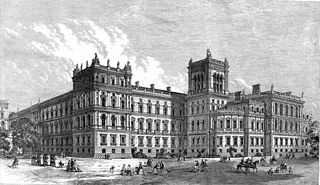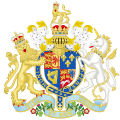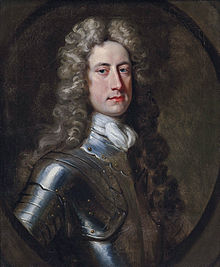
The Admiralty was a department of the Government of the United Kingdom responsible for the command of the Royal Navy until 1964, historically under its titular head, the Lord High Admiral – one of the Great Officers of State. For much of its history, from the early 18th century until its abolition, the role of the Lord High Admiral was almost invariably put "in commission" and exercised by the Lords Commissioner of the Admiralty, who sat on the governing Board of Admiralty, rather than by a single person. The Admiralty was replaced by the Admiralty Board in 1964, as part of the reforms that created the Ministry of Defence and its Navy Department.

The Foreign, Commonwealth & Development Office (FCDO) is a department of the Government of the United Kingdom. Equivalent to other countries' ministries of foreign affairs, it was created on 2 September 2020 through the merger of the Foreign & Commonwealth Office (FCO) and the Department for International Development (DFID). The FCO was itself created in 1968 by the merger of the Foreign Office (FO) and the Commonwealth Office. The department in its various forms is responsible for representing and promoting British interests worldwide.

The secretary of state for foreign, Commonwealth and development affairs is a secretary of state in the Government of the United Kingdom, with responsibility for the Foreign, Commonwealth and Development Office. Seen as one of the most senior ministers in the government and a Great Office of State, the incumbent is a member of the Cabinet of the United Kingdom.

The secretary of state for the Home Department, more commonly known as the Home secretary, is a senior minister of the Crown in the Government of the United Kingdom and the head of the Home Office. The position is a Great Office of State, making the home secretary one of the most senior and influential ministers in the government. The incumbent is a statutory member of the British Cabinet and National Security Council.

Postmaster General of the United Kingdom was a Cabinet ministerial position in HM Government. Aside from maintaining the postal system, the Telegraph Act 1868 established the Postmaster General's right to exclusively maintain electric telegraphs. This would subsequently extend to telecommunications and broadcasting.

The secretary of state for the colonies or colonial secretary was the Cabinet of the United Kingdom's minister in charge of managing the British Empire.

The Secretary of State for the Southern Department was a position in the cabinet of the government of the Kingdom of Great Britain up to 1782, when the Southern Department became the Home Office.
An interior minister is a cabinet official position that is responsible for internal affairs, such as public security, civil registration and identification, emergency management, supervision of regional and local governments, conduct of elections, public administration and immigration matters. This position is head of a department that is often called an interior ministry, a ministry of internal affairs or a ministry of home affairs. In some jurisdictions, there is no department called an "interior ministry", but the relevant responsibilities are allocated to other departments.

The Board of Trade is a British government body concerned with commerce and industry, currently within the Department for Business and Trade. Its full title is The Lords of the Committee of the Privy Council appointed for the consideration of all matters relating to Trade and Foreign Plantations, but is commonly known as the Board of Trade, and formerly known as the Lords of Trade and Plantations or Lords of Trade, and it has been a committee of the Privy Council of the United Kingdom. The board has gone through several evolutions, beginning with extensive involvement in colonial matters in the 17th century, to powerful regulatory functions in the Victorian Era and early 20th century. It was virtually dormant in the last third of the 20th century. In 2017, it was revitalised as an advisory board headed by the International Trade Secretary who has nominally held the title of President of the Board of Trade, and who at present is the only privy counsellor of the board, the other members of the present board filling roles as advisers.

The Northern Department was a department of the government of the Kingdom of England from 1660 to 1707 and later the Kingdom of Great Britain from 1707 until 1782 when its functions were reorganised into the new Home Office and Foreign Office.

The Southern Department was a department of the government of the Kingdom of England and later the Kingdom of Great Britain from 1660 until 1782 when its functions were reorganised into the new Home Office and Foreign Office. The department was tasked with home affairs, foreign affairs in parts of Southern Europe, and with governing the English and later British colonies, among other matters.

His Majesty's principal secretaries of state, or secretaries of state, are senior ministers of the Crown in the Government of the United Kingdom. Secretaries of state head most major government departments and make up the majority of the Cabinet of the United Kingdom. There are currently 17 secretaries of state. They are all also currently members of Parliament elected to the House of Commons, although it is possible for them to be members of the House of Lords.
A private secretary (PS) is a civil servant in a governmental department or ministry, responsible to a secretary of state or minister; or a public servant in a royal household, responsible to a member of the royal family.

The Colonial Office was a government department of the Kingdom of Great Britain and later of the United Kingdom, first created in 1768 from the Southern Department to deal with colonial affairs in North America, until merged into the new Home Office in 1782.

In the Kingdom of England, the title of Secretary of State came into being near the end of the reign of Elizabeth I, the usual title before that having been King's Clerk, King's Secretary, or Principal Secretary.
The title secretary of state or state's secretary is commonly used for senior or mid-level posts in governments around the world. The role varies between countries, and in some cases there are multiple secretaries of state in the country's system of governing the country.

The Admiralty and Marine Affairs Office (1546–1707), previously known as the Admiralty Office (1414–1546), was a government department of the Kingdom of England, responsible for the Royal Navy. First established in 1414 when the offices of the separate Admiral of the North and West were abolished and their functions unified under a single centralised command, it was headed by the Lord High Admiral of England. The department existed until 1707 when England and Scotland united to form the Kingdom of Great Britain, after which it was known as the British Admiralty.

During the early 17th century, England's relative naval power deteriorated; in the course of the rest of the 17th century, the office of the Admiralty and Marine Affairs steered the Navy's transition from a semi-amateur Navy Royal fighting in conjunction with private vessels into a fully professional institution, a Royal Navy. Its financial provisions were gradually regularised, it came to rely on dedicated warships only, and it developed a professional officer corps with a defined career structure, superseding an earlier mix of sailors and socially prominent former soldiers.

The Glorious Revolution of 1688 rearranged the political map of Europe, and led to a series of wars with France that lasted well over a century. This was the classic age of sail; while the ships themselves evolved in only minor ways, technique and tactics were honed to a high degree, and the battles of the Napoleonic Wars entailed feats that would have been impossible for the fleets of the 17th century. Because of parliamentary opposition, James II fled the country. The landing of William III and the Glorious Revolution itself was a gigantic effort involving 100 warships and 400 transports carrying 11,000 infantry and 4,000 horses. It was not opposed by the English or Scottish fleets.

The Marine Department, originally called the Marine Office, was created in 1755 as a result of the formation of the Corps of the Royal Marines and was a department within the Admiralty. The department was a civilian secretariat responsible for corresponding with the various Royal Marine Divisions. It existed until 1809 when its functions were merged into the Marine Pay Department. The department was administered by the First Secretary of the Marine who was supported by a deputy the Second Secretary of the Marine.















































